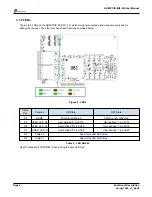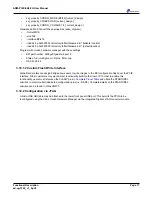
ADM-PCIE-8K5-FH User Manual
ftp://ftp.alpha-data.com/pub/firmware/utilities/windows/archive/avr2util-win-2.5.0.zip
The USB driver install file is downloadable here:
ftp://ftp.alpha-data.com/pub/firmware/utilities/windows/archive/avr2_usb_inf.zip
Use "avr2util.exe /?" to see all options.
For example "avr2util.exe /usbcom com4 display-sensors" will display all sensor values.
3.10 Configuration
There are two main ways of configuring the FPGA on the ADM-PCIE-8K5-FH:
•
From Flash memory, at power-on, as described in
Section 3.10.1
•
Using USB cable connected at the lower USB port found on the front panel. This process is described in
Section 3.10.2
3.10.1 Configuration From Flash Memory
The FPGA can be automatically configured at power-on from a 1 Gbit BPI flash memory device (Micron part
number MT28GU01GAAA1EGC-0SIT). This Flash device is divided into two regions of 64 MiByte each, where
each region is sufficiently large to hold an uncompressed bitstream for a KU115 FPGA.
The ADM-PCIE-8K5-FH is shipped with a bitstream, corresponding to the "dma_demo" FPGA design from the
ADM-PCIE-8K5-FH SDK, programmed into region 1 and "reg_access" programmed into region 0. This permits
basic confidence and performance testing to be performed on a board without needing to program anything into
the Flash memory. Alpha Data recommends that region 0 is used as a fallback image; this permits relatively
simple recovery, without requiring direct programming of the FPGA over the front panel USB connection, in the
event of programming a "bad" bitstream into region 1.
The flash address map is as detailed below:
D
at
a
R
eg
io
n
Region 0
Failsafe
(64 MiB)
Region 1
Default
(64 MiB)
Start Address (Bytes)
0x000_0000
0x400_0000
Figure 12 : Flash Address Map
At power-on, the FPGA attempts to configure itself automatically in BPI mode from region 1 unless the
configuration header on the bitstream ultilizes multi-boot. Multibook and ICAP can be used to selected between
the two configuration regions to be loaded into the FPGA. See Xilinx UG570 MultiBoot for details.
The Lockdown function of the Flash device is controlled via switch SW1-2. When SW1-2 is OFF, any blocks in
the Flash whose Lockdown flag is set are write-protected. The factory default for the Lockdown flag of all Flash
blocks is clear, so that any block in the Flash can be written.
3.10.1.1 Building and Programming Configuration Images
Generate a bitfile with these constraints (see XAPP587):
•
set_property BITSTREAM.GENERAL.COMPRESS {TRUE} [ current_design ]
•
set_property BITSTREAM.CONFIG.EXTMASTERCCLK_EN {DIV-1} [current_design]
•
set_property BITSTREAM.CONFIG.BPI_SYNC_MODE {TYPE1} [current_design]
•
set_property BITSTREAM.CONFIG.UNUSEDPIN {Pullnone} [current_design]
•
set_property BITSTREAM.CONFIG.OVERTEMPSHUTDOWN Enable [current_design]
Page 16
Functional Description
ad-ug-1342_v1_0.pdf
















































